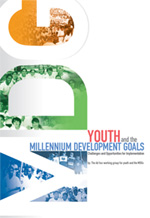 |
the millennium development goals
 |
 |
 only with
only with
your voice
 |
youth in policy
 |
As young people, we often feel that we cannot contribute to policy processes. While it is extremely difficult, there are some successful examples of young people getting heard. The report "Youth and the Millennium Development Goals (MDGs) - Challenges and Opportunities for Implementation" is one of them.
If you want to learn more about the content of the report and how it came about - then read on!
The Millenium Project and Youth
In 2002 UN Secretary-General Kofi Annan invited a large group of development experts to form the Millennium Project . Headed by Professor Jeffrey Sachs, a well-known economist at Columbia University in New York, the Millennium Project set out to create a concrete action plan for how the MDGs can be achieved. On January 17, 2005, the Millennium Project Report was released, and it concluded that it is possible to achieve the MDGs by 2015, but not if we continue on today's path. The report outlined a number of steps the world needs to take if we are serious about our ambition to end poverty and human suffering.
Young people have a special interest in seeing the recommendations of the report transformed into real action. In 2015 many of us will be adults with families and children, and the actions of the world leaders in the next couple of years will do much to determine how the world will look in 10 years. So, how can we as young people get involved with the MDGs? A group of young people has tried to answer that question, after being challenged to do so by Professor Sachs.
How it all began
In April 2004 the UN Commission on Sustainable Development held its annual meeting at the UN Headquarter in New York . The Commission meets to review the progress towards sustainable development and then to make recommendations on how we can make that progress better and quicker. It consists of politicians and government officials from member countries of the UN, and members of civil society are invited to join the discussions. A group of dedicated youth from around the world has formed a Youth Caucus through which they participate in the annual Commission meetings in order to ensure that the voices of young people would be heard. During the Commission, Professor Sachs attended a meeting on the MDGs. The Chair of the Youth Caucus asked him how the Millennium Project was going to involve young people as partners. He replied: You tell us.
Taking on the challenge by Professor Sachs, an international team of youth experts from all over the world formed a working group and decided to write a paper on how young people can get involved with the MDGs. The members, all young people, spent hours researching and consulting with other organizations. In order to ensure a broad representation, a 3-week online consultation with over 350 youth from around the world was held. These efforts, in addition to input based on the experience and expertise of the writers, resulted in the report called
"Youth and the Millennium Development Goals (MDGs): Challenges and Opportunities for Implementation."
The Youth and MDG Paper
 The report consists of three parts. The first part outlines how youth are already involved in decision-making processes in government bodies and civil society organizations. The level of participation ranges from effective to non-existent. The second part goes into detail on each Goal and describes how young people are affected by the Goal, how young people are already contributing to the Goal, and what can be done to increase youth participation in achieving the Goal. For each Goal there are several "Options for Action" concrete suggestions for how national and international institutions can get more young people involved. The third and final part of the report contains general recommendations and focuses on how young people can get involved with the Goals through raising awareness, taking part in policy decisions, taking action, and networking and collaborating. Overall, the report is a call out to governments and institutions to get more youth involved with the Goals.
The report consists of three parts. The first part outlines how youth are already involved in decision-making processes in government bodies and civil society organizations. The level of participation ranges from effective to non-existent. The second part goes into detail on each Goal and describes how young people are affected by the Goal, how young people are already contributing to the Goal, and what can be done to increase youth participation in achieving the Goal. For each Goal there are several "Options for Action" concrete suggestions for how national and international institutions can get more young people involved. The third and final part of the report contains general recommendations and focuses on how young people can get involved with the Goals through raising awareness, taking part in policy decisions, taking action, and networking and collaborating. Overall, the report is a call out to governments and institutions to get more youth involved with the Goals.
The report was initially released in November 2004, and the working group encouraged everyone to provide comments and feedback. During the space of 4 months, the report was downloaded more than 24,000 times! After all the feedback and comments had been considered, the finalized version of the report was written. The official release took place at the Commission on Sustainable Development on April 19, 2005, one year after the challenge from Professor Sachs.The report will be used as a lobbying tool in upcoming conferences and summits on the MDGs, but most of all, the report aims to serve as a starting point for greater discussion on how young people can get involved with the MDGs.
You can download the report here!
|
 |
|
 |

